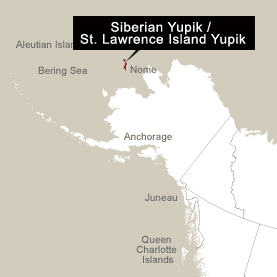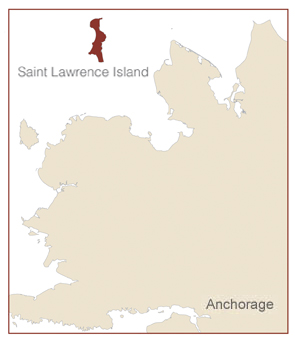
“St. Lawrence Island, Alaska, is noted both archaeologically and historically for its important role in the development of Arctic cultures. Located in the Bering Sea, it lies less than 200 miles south of the Bering Strait, about 125 miles southwest of Nome on the Alaskan mainland, and its northwestern tip is only 40 miles from Siberia. It is believed to be one of the few remaining nonsubmerged parts of a land bridge connecting the New and Old Worlds during the Pleistocene period that allowed migrating groups from Asia to enter North America. The prehistoric and historic Eskimo cultures of the island show links with groups on both sides of the Bering Strait.
The island contains a number of significant sites in the development of Bering Sea prehistory, and has produced an extensive artifactual record important in establishing a chronology for occupation of the region. This prehistoric cultural chronology, which continues to be reformulated, is generally as follows: Old Bering Sea/Okvik period (ca. A.D. 1–700 A.D.), Birnirk/Punuk period (ca. A.D 500–1200), and Thule period (ca. A.D. 900–1500). Assemblages dating from all these periods show items related to an Arctic sea-mammal-hunting lifestyle, with stylistic differences in artifacts used by different groups.

The historic Saint Lawrence Island Eskimo traditionally followed a lifestyle like that of their prehistoric ancestors. These historic inhabitants are related culturally to Asiatic Eskimo groups rather than to those of North America. Their language, Siberian Yupik (also known as Central Siberian Yupik), is the only language spoken by people on both sides of the Bering Strait and most clearly shows their continued link with Eskimo groups of Siberian Asia.”
Source: Text Copyright of the Museum of Anthropology website
